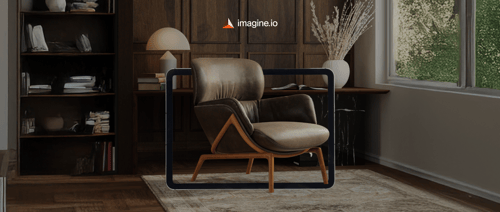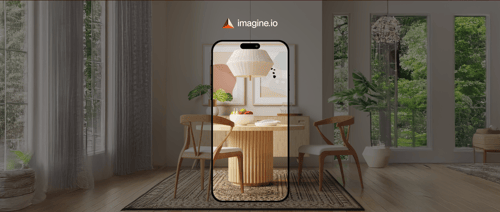Have you ever paused while scrolling, wondering if that product you saw was a photo—or a digital render? That moment of hesitation says a lot. It’s proof that 3D product visualization has evolved—and artificial intelligence is the driving force behind that transformation.
If you’re in retail, furniture, bedding, or any other product-centric business, you know visuals aren’t just decoration. They’re decision-makers. The better your visuals, the faster your conversions, the fewer your returns, and the stronger your brand perception. But today’s consumers and buyers expect more than just good visuals. They want realism—and that’s where AI-enhanced 3D rendering comes in.
Let’s unpack what it is, how it works, and why it’s becoming an essential strategy—not just a visual upgrade—for businesses like yours.
Get the latest updates straight to your inbox.
By clicking sign up you'll receive occasional emails from imagine.io. You always have the choice to unsubscribe within every email you receive.
Let’s Talk Technology: How AI Achieves Photorealism
Creating visuals that look real takes more than good design—it takes smart algorithms that can simulate how materials, light, and environments behave. Here’s how AI makes that happen.
-
AI-Powered Material Mapping
In traditional 3D modeling, surfaces often look flat or synthetic. They lack the subtle imperfections that make something feel real—like the grain of wood, the depth of suede, or the way foam subtly compresses under pressure.
AI changes that. By analyzing thousands of high-resolution images of real-world materials, it learns how different surfaces behave under various lighting and tactile conditions. It then applies those learnings to your 3D model—automatically.
Take imagine.io’s mattress clients, for instance. They’re using high-resolution AI-generated textures to simulate memory foam, hybrid cores, and plush toppers. There’s no photography involved, yet the textures are so rich and true-to-life that customers often can’t tell they’re looking at a render.
According to NVIDIA, their texture synthesis AI can recreate realistic material maps with up to 90% accuracy compared to real-world photographs.
-
Lighting Intelligence That Understands the Scene
In real life, lighting isn’t static. It shifts depending on the room, time of day, and objects in the environment. Now, thanks to AI, lighting in 3D scenes behaves the same way.
Instead of you having to manually place light sources or simulate sunlight, AI can analyze the scene and generate lighting that makes sense contextually. Morning light? Evening glow? Studio spotlight? It adapts instantly and naturally.
One furniture brand using imagine.io created visuals of their sectional sofa in three very different environments—a bright urban loft at noon, a cozy living room at dusk, and a sterile showroom floor.
The lighting in each was not only realistic, but also emotionally resonant. As a result, engagement on their website product pages increased significantly, with more time spent exploring each scene.
-
Smart Camera Angles and Composition with Neural Rendering
AI doesn’t just help with surfaces and lighting—it also acts like a virtual director, finding the best angles to showcase your product.
Neural rendering technology simulates how a camera might behave in a real shoot, determining optimal perspectives, depth of field, and even zoom levels. This takes a huge burden off creative teams who would otherwise spend hours staging shots or adjusting framing.
And here’s the kicker: camera angle matters more than we think. A Shopify study revealed that adding interactive 3D visuals can boost product page conversions by up to 250%. The right angle, powered by AI, can help a customer understand the product better and make a decision faster.
-
Generative Backgrounds and Custom Scenes—On Demand
Traditionally, setting the scene meant scouting locations, hiring stylists, and building physical sets. AI eliminates all of that.
Generative AI tools can create on-brand, high-end backgrounds tailored to your product category and audience. For example, a luxury home goods brand using imagine.io was able to drop their products into high-end living spaces—coastal condos, chic downtown apartments, and boutique hotel rooms.
The visuals not only looked realistic, but matched their aspirational brand identity perfectly.
These scenes are consistent, scalable, and—unlike physical sets—editable at any time. Need to change the color scheme or swap props? Just a few clicks.
Why This Isn’t Just a Visual Upgrade—It’s a Strategic Advantage
AI-powered 3D visualization is not just about making products look good. It’s transforming product marketing by addressing critical operational and creative challenges that impact speed, scalability, and consistency.
-
Speed to Market
Traditional photoshoots are time-consuming, often taking weeks due to sample logistics, scheduling, and post-production.
AI-enhanced rendering drastically reduces this timeline, enabling teams to create high-quality visuals in days—not weeks. This acceleration is crucial when trying to stay ahead of competitors or meet seasonal demands.
-
Scalability Without Extra Overhead
AI doesn’t just create one image—it builds a system. Launching dozens of SKUs across various colors, textures, and room settings becomes seamless.
Without the need for physical inventory or elaborate shoots, design teams can scale visual production exponentially, without scaling costs or complexity.
-
Cost Savings Across the Board
Photoshoots come with a long list of expenses: studios, props, transportation, crews, and editing. AI eliminates much of this overhead. Brands shifting to 3D visual workflows can significantly reduce content production costs—freeing up budget for innovation and growth.
-
Brand Consistency Across All Channels
Disjointed visuals across platforms can erode customer trust. AI-generated content ensures uniformity in lighting, angles, and styling across eCommerce, print, social, and marketplace listings. This consistency reinforces brand credibility and supports a smoother buyer journey.
-
More Creative Time for the Work That Matters
AI handles the repetitive, technical aspects of visual creation—like rendering, lighting adjustments, and environment setups. This gives creative teams more time to focus on strategy, storytelling, and brand-building initiatives that drive deeper customer engagement.
Better Visuals = Better Buyer Experience
Your buyers are looking for more than specs and price. They want to see and feel your product digitally. Here’s how AI-enhanced 3D renders improve their experience:
-
Interactive Exploration
Modern consumers seek more than static images; they desire immersive experiences. AI-powered 3D renders enable users to rotate products, zoom into intricate details, and even visualize items in their own space through augmented reality (AR).
This level of interactivity not only captivates users but also facilitates informed purchasing decisions. Notably, 91% of B2B buyers prefer visual and interactive content over traditional formats, highlighting the significance of engaging visuals in the decision-making process.
-
Clarity That Reduces Returns
High return rates often stem from discrepancies between product expectations and reality. AI-generated 3D visuals provide accurate representations of products, capturing textures, dimensions, and functionalities with precision. This clarity helps set correct expectations, thereby reducing the likelihood of returns.
For instance, brands utilizing digital twin avatars—AI-generated models that mirror customers' proportions—have observed significant reductions in return rates. Deepgears, a provider of such technology, reported an average 25% decrease in returns and a 28% increase in conversions for items offering digital mannequin options.
-
Confidence That Drives Conversions
Accurate and detailed product visuals serve as a virtual salesperson, instilling confidence in potential buyers. When customers can examine realistic textures, assess true-to-scale dimensions, and view products in lifelike environments, they are more likely to proceed with a purchase.
Moreover, the integration of interactive content has been shown to double conversion rates compared to passive content, emphasizing its effectiveness in guiding customers through the purchasing journey.
Where imagine.io Fits In
AI-driven rendering is powerful, but the right platform makes all the difference. At imagine.io, we’ve built a solution that combines intuitive design tools with cutting-edge AI to help businesses like yours create photorealistic visuals—fast.
From mattresses and bedding to home goods and electronics, imagine.io gives you full control over materials, lighting, and scenes—without requiring a background in 3D design. The result? High-quality product visuals that scale, convert, and deliver ROI across your marketing and sales funnels.
Ready to See AI-Enhanced Visualization in Action?
Your next product launch doesn’t need to start with a warehouse or a camera crew. It can start with a digital model and a smart visualization platform. Whether you’re aiming to improve your product pages, streamline your creative workflows, or reduce content production costs—AI-enhanced rendering is the edge you’ve been looking for.
Book a Free Demo at imagine.io. Discover how you can transform your visuals—and your results.


.gif?width=1296&height=1296&name=Untitled%20design%20(8).gif)



.png?width=500&name=How%20to%20Add%20a%203D%20Product%20Configurator%20to%20Your%20WordPress%20Website%20(Complete%20B2B%20Guide).png)
















%20(1).png?width=500&name=Why%20Exploded%20Mattress%20Views%20Matter%20(And%20How%20to%20Generate%20Them)%20(1).png)
.png?width=500&name=Best%20Shopify%20Product%20Configurator_%20How%20to%20Choose%20the%20Right%20One%20(2).png)
.png?width=500&name=Why%20Exploded%20Mattress%20Views%20Matter%20(And%20How%20to%20Generate%20Them).png)



.png?width=500&name=Best%20Shopify%20Product%20Configurator_%20How%20to%20Choose%20the%20Right%20One%20(1).png)







.png?width=500&name=How%203D%20Rendering%20Can%20Make%20or%20Break%20Your%20Industrial%20Design%20Pitch%20(1).png)








%20with%20Digital%20Twins%20and%203D%20Visualization.png?width=500&name=Optimizing%20Your%20Digital%20Asset%20Management%20(DAM)%20with%20Digital%20Twins%20and%203D%20Visualization.png)




.png?width=500&name=Styling%20Home%20Decor%20for%202025_%20From%20Global%20Influences%20to%20Playful%20Personalization%20(1).png)

